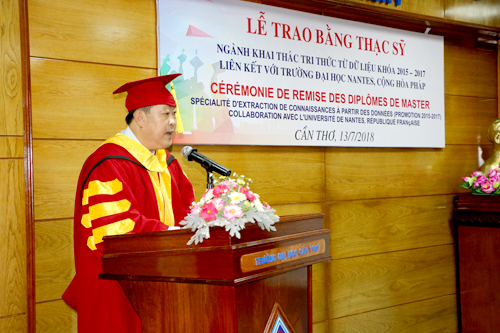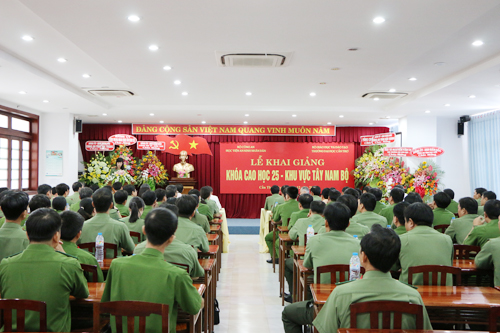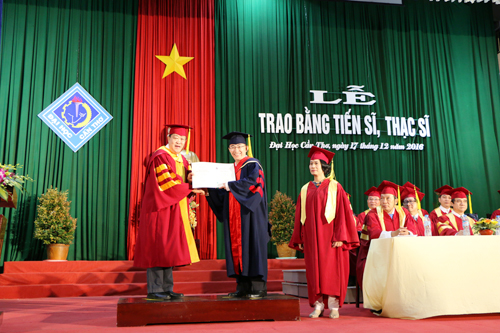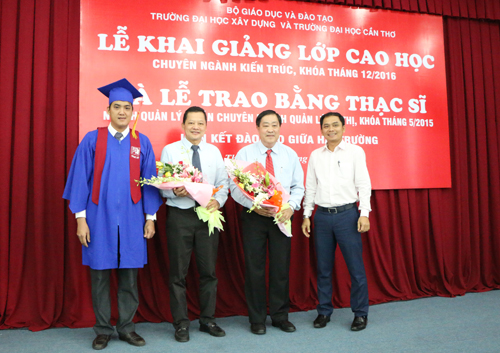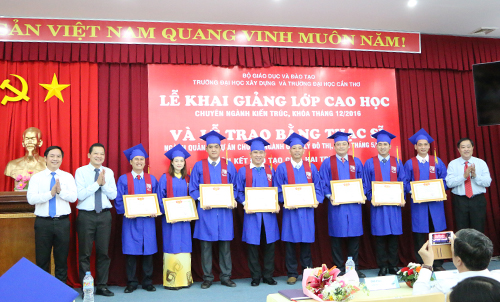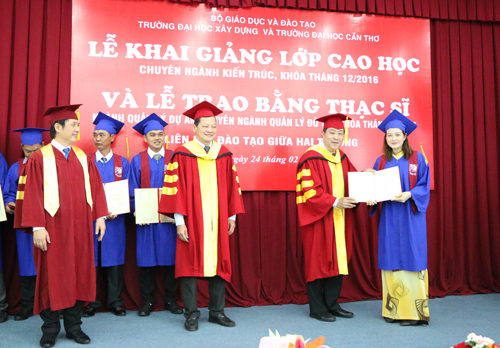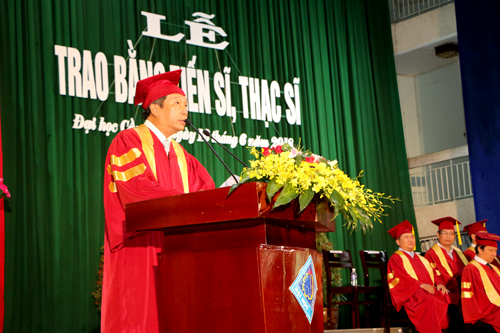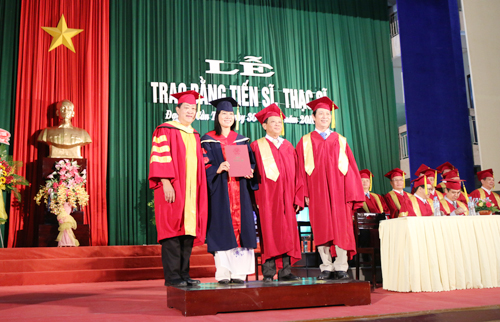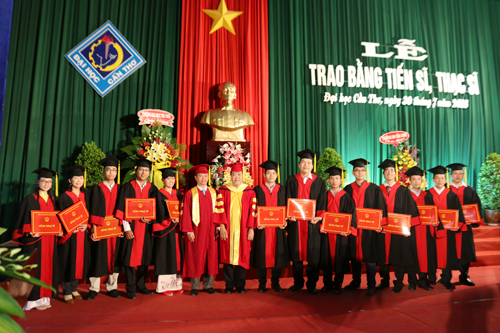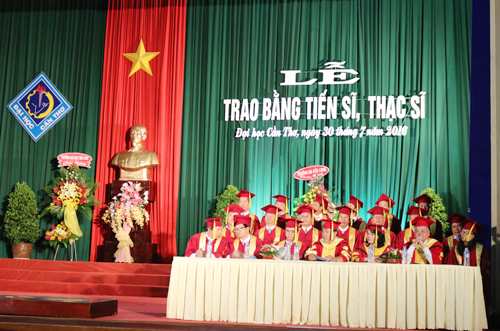
Tên đề tài: “Nghiên cứu chế tạo màng chitosan-nano bạc và bước đầu thử nghiệm trong bảo quản xoài cát Hòa Lộc”.
Tác giả: Nguyễn Huỳnh Đình Thuấn, Khóa: 2014
Chuyên ngành: Công nghệ thực phẩm; Mã số: 62540101. Nhóm ngành: Công nghệ sản xuất và chế biến
Người hướng dẫn chính: PGS.TS. Lý Nguyễn Bình - Trường Đại học Cần Thơ.
- Tóm tắt nội dung luận án:
Nghiên cứu này thực hiện nhằm tận dụng chitosan được sản xuất từ phế liệu vỏ tôm của các nhà máy chế biến thủy sản, tiến hành khảo sát các thông số kỹ thuật thích hợp tạo ra màng chitosan-nano bạc tốt nhất. Sử dụng màng chitosan-nano bạc bọc bảo quản xoài cát Hòa Lộc, theo dõi sự biến đổi chất lượng của quả trong quá trình bảo quản.
Nội dung 1 của luận án bao gồm các thí nghiệm nghiên cứu ảnh hưởng của nồng độ (0,5÷1,5%) và độ deacetyl (70, 80 và 90%) của chitosan đến khả năng tạo màng chitosan thông qua việc khảo sát các chỉ tiêu cơ lý và khả năng kháng nấm Colletotrichum gloeosporioides và Fusarium equiseti của màng.
Nội dung 2 của luận án bao gồm quá trình nghiên cứu chế tạo màng chitosan-nano bạc thông qua việc (i) nghiên cứu ảnh hưởng của nồng độ AgNO3 (0,001÷0,01 M), nhiệt độ (90÷100 oC) và thời gian khuấy (4÷12 phút) đến khả năng chế tạo keo nano bạc, (ii) nghiên cứu ảnh hưởng của tỉ lệ phối trộn dung dịch AgNO3 0,005 M (50, 75 và 100 µL) với dung dịch chitosan 1% (100 mL) và độ deacetyl (70, 80, và 90%) của chitosan đến khả năng tạo màng chitosan-nano bạc và đánh giá khả năng kháng nấm của màng chitosan-nano bạc đối với 2 chủng nấm gây bệnh trên xoài là Colletotrichum gloeosporioides và Fusarium equiseti.
Nội dung 3 của luận án bao gồm các nghiên cứu đánh giá khả năng bảo quản tươi xoài cát Hoà Lộc bằng cách bao màng chitosan-nano bạc so sánh với các cách xử lý bảo quản khác. Xoài được xử lý bằng cách rửa bằng nước ở nhiệt độ phòng hoặc nước ở 50 oC kết hợp với bao trái bằng màng chitosan hoặc màng chitosan nano-bạc (ở ba độ deacetyl khác nhau) và bảo quản ở 12 oC.
Kết quả nghiên cứu cho thấy, ở nội dung 1, khả năng hòa tan của chitosan với ba độ deacetyl 70, 80 và 90% trong dung dịch acid acetic phụ thuộc vào giá trị pH của dung dịch. pH 3,6 là giá trị thích hợp để hòa tan chitosan có độ deacetyl 70%, trong khi pH 3,8 thích hợp để hòa tan chitosan có độ deacetyl 80 và 90%. Nồng độ chitosan (độ deacetyl 70, 80 và 90%) 1% là giá trị phù hợp để tạo màng chitosan có độ dày 20-21 µm, thích hợp để ứng dụng làm màng bao các loại trái cây tươi.
Ở nội dung 2, điều kiện tối ưu để tạo dung dịch nano bạc bao gồm AgNO3 0,005 M, nhiệt độ khuấy 96 oC và thời gian khuấy 12 phút. Tỉ lệ nguyên liệu thích hợp để tạo màng chitosan-nano bạc là 75 µL dung dịch AgNO3 0,005 M phối trộn với 100 mL dung dịch chitosan với độ deacetyl 70, 80 và 90%. nồng độ 1%. Màng chitosan-nano bạc tạo thành có độ ổn định cao với các hạt nano bạc phân bố đều.
Ở nội dung 3, kết quả đánh giá chất lượng bảo quản xoài cát Hòa Lộc qua các chỉ tiêu độ cứng thịt quả, hàm lượng đường tổng, vitamin C, acid tổng, hàm lượng chất khô hoà tan, cường độ hô hấp, khả năng sinh khí ethylene và tỷ lệ hư hỏng cho thấy, thời gian bảo quản các mẫu xoài không bao màng chitosan hoặc màng chitosan-nano bạc là dưới 10 ngày. Thời gian bảo quản các mẫu xoài được bao gói bằng màng chitosan có độ deacetyl 70% (không chứa nano bạc) là 25 ngày, trong khi thời gian bảo quản bằng màng chitosan có độ deacetyl 80 và 90% (không chứa nano bạc) là 30 ngày. Thời gian bảo quản các mẫu xoài được bao gói bằng màng chitosan-nano bạc có độ deacetyl 70, 80 và 90% là 35 ngày. Chất lượng hóa lý và cảm quan của các mẫu xoài được bao gói bằng màng chitosan-nano bạc với độ deacetyl 70, 80 và 90% sau 35 ngày bảo quản không có sự khác biệt có ý nghĩa. Kết quả nghiên cứu cho thấy việc sử dụng màng bao chitosan-nano bạc trong bảo quản xoài là một hướng tiếp cận nhiều triển vọng.
- Những kết quả mới của luận án:
Đây là nghiên cứu có tính tổng thể bao gồm (i) việc tối ưu hóa quá trình tạo màng bao sinh học từ vật liệu chitosan kết hợp với nano bạc ở ba độ deacetyl khác nhau (70, 80 và 90%), với các tính chất cơ lý và sinh học phù hợp được ứng dụng để bảo quản tươi quả xoài cát Hòa Lộc.
Tính mới thứ nhất, đề tài đã tạo được màng chitosan-nano bạc có tính chất cơ lý, tính thấm hơi nước qua màng phù hợp, khả năng kháng nấm Colletotrichum gloeosporioides và Fusarium equiseti có hiệu quả cao trong bảo quản xoài cát Hòa Lộc, với các thông số tạo màng như pH hòa tan chitosan thích hợp là 3,6 cho độ deacetyl 70%, 3,8 cho độ deacetyl 80%. 90%, nồng độ 1% phù hợp cho cả 3 loại deacetyl, tỉ lệ dung dịch nano bạc là 75 µL dung dịch AgNO3 0,005 M phối trộn với 100 mL dung dịch chitosan với độ deacetyl 70% 80% và 90%).
Tính mới thứ hai, các nghiên về chitosan đã được công bố chủ yếu tạo chế phẩm dung dịch chitosan ứng dụng trong bảo quản thực phẩm. Kết quả nghiên cứu này tạo ra màng chitosan-nano bạc có các tính chất như một màng bao thực phẩm. Hơn nữa, màng tạo thành còn có khả năng kháng nấm tốt, sử dụng trong trong bảo quản xoài hay các loại trái cây có kích thước và khối lượng trung bình rất dễ và tiện lợi.
Tính mới thứ ba, Kết quả dùng màng chitosan- nano bạc bảo quản xoài cát Hòa Lộc được 35 ngày mà vẫn giữ được được chất lượng tốt so với các phương pháp bảo quản khác trong khảo sát, kéo dài thêm thời gian bảo quản từ 5-10 ngày so với các công trình nghiên cứu bảo quản xoài khác. Điều này có ý nghĩa rất lớn trong việc bảo quản các loại trái cây có giá trị kinh tế cao hiện nay.
Tính mới thứ tư, kết quả nghiên cứu sử nguồn chitosan độ deacetyl 85-95% đã được nghiên cứu và công bố, có khả năng bảo quản và kháng nấm rất tốt, các loại trái cây. Trong nghiên cứu này, sử dụng chitosan độ deacetyl thấp, 70-80% tạo màng và ứng dụng bảo quản xoài, thực nghiệm cho thấy hiệu quả bảo quản không khác biệt về biến đổi chất lượng xoài cát Hòa Lộc so với chitosan có độ deacetyl 90%. Đều này cũng góp phần cho việc ứng dụng đa dạng chitosan trong bảo quản thực phẩm hiện nay.
- Các ứng dụng/khả năng ứng dụng trong thực tiễn, các vấn đề cần tiếp tục nghiên cứu:
- Kết quả của đề tài có thể góp phần nâng cao hiệu quả kinh tế cho người trồng trọt, kinh doanh, vận chuyển, xuất khẩu xoài cát Hòa Lộc. Từ đó tạo động lực thúc đẩy việc quy hoạch mở rộng diện tích trồng xoài, nâng cao số lượng cũng như chất lượng trong xuất khẩu, phát triển bền vững thương hiệu xoài cát Hòa Lộc Việt Nam trên thị trường trong và ngoài nước.
- Hơn nữa ngoài việc bảo quản xoài, màng chitosan-nano bạc cũng có thể ứng dụng bảo quản cho nhiều loại trái cây khác hay các loại thực phẩm khác trong xử lý sau thu hoạch hay chế biến nâng cao chất lượng sản phẩm.
Thesis title: “Development of chitosan-based nanosilver films and preliminary application for storage of Hoa Loc mango”
Major: Food Technology Code: 62 54 01 01
PhD student: Nguyen Huynh Dinh Thuan
Scientific advisor: Prof. Dr. Ly Nguyen Binh
Training Institute: Can Tho University
- Research abstract
This study was conducted to utilize chitosan produced from shrimp shell of seafood processing plants, to investigate the appropriate technical parameters to create the best silver chitosan-nano films. Using silver chitosan-nano film to preserve Hoa Loc mango, monitor the quality change of the fruit during storage.
Part 1 of the thesis includes the experiments to determine the effect of concentration (0.5÷1.5%) and deacetylation degree (70, 80, and 90%) of chitosan on the ability to form chitosan film through the investigation of its physico-mechanical parameters and antifungal activity against Colletotrichum gloeosporioides and Fusarium equiseti.
Part 2 of the thesis includes the experiments to fabricate chitosan-based nano-silver films through (i) studying the influence of AgNO3 concentration (0.001÷0.01 M), temperature (90÷100 oC) and stirring time (4÷12 minutes) on the ability to form silver nanoparticle solution, (ii) investigating the effect of mixing ratio of 0.005 M AgNO3 solution (50, 75 and 100 µL) with 1% chitosan solution (100 mL) and deacetylation degree (70, 80, and 90%) of chitosan on the ability to form chitosan-based nano-silver films and evaluate its antifungal activity against 2 pathogenic fungal strains Colletotrichum gloeosporioides and Fusarium equiseti.
Part 3 of the thesis includes the studies on evaluating the ability to preserve fresh Hoa Loc mangoes by coating the fruits using chitosan-based nano-silver films compared with other preservation treatments. Mangoes were treated by washing with water at room temperature or water at 50 oC combined with fruit wrapping using chitosan film or chitosan-based nano-silver film (with three different deacetylation degrees) and stored at 12 oC.
The results showed that, in part 1, the solubility of chitosan with three degrees of deacetylation 70, 80 and 90% in acetic acid solution depended on the pH value of the solution. pH 3.6 was suitable for dissolving chitosan with 70% deacetylation degree, while pH 3.8 was suitable for dissolving chitosan with deacetylation degree of 80 and 90%. The chitosan concentration (70, 80 and 90% deacetylation) of 1% was suitable for forming chitosan films with a thickness of 20-21 µm, suitable for application as coating materials for fresh fruits.
In part 2, the optimal conditions for forming silver nanoparticle solution included 0.005 M AgNO3, stirring temperature of 96 oC and stirring time of 12 minutes. The appropriate ratio of materials to fabricate chitosan-based nano-silver films was 75 µL of 0.005 M AgNO3 solution mixed with 100 mL of 1% chitosan solution with 70% 80% and 90% deacetylation. The fabricated chitosan-based nano-silver films showed good stability with the silver nanoparticles evenly distributed.
In part 3, the results of evaluating the preservation quality of Hoa Loc mangoes based upon criteria including pulp hardness, total sugar, vitamin C, total acid, soluble dry matter content, respiratory intensity, ethylene production and spoilage rate showed that the storage time of mango samples without chitosan or chitosan-based nano-silver film coating was less than 10 days. The storage time of mango samples coated with chitosan film with 70% deacetylation (not incorporated with silver nanoparticle) was 25 days, while those of mango samples coated with chitosan film with deacetylation degree of 80 and 90% (not incorporated with silver nanoparticle) was 30 days. The preservation time of mango samples coated with chitosan-based nano-silver film with deacetylation of 70, 80 and 90% was 35 days. The physicochemical and sensorial quality of Hoa Loc mangoes coated with chitosan-based nano silver films with deacetylation degree of 70, 80 and 90% after 35 days of storage was not significantly different. It is good to mention that the application of chitosan-based nano-silver film for mango storage (among others) is a very promising approach.
- The new findings of the dissertation
This is an overall study that includes (i) the optimization of biofilm-making from chitosan materials in combination with silver nanoparticles at three different deacetyl degrees (70, 80 and 90%), with suitable physical and biological properties applied to fresh preservation of Hoa Loc mango.
The first newly, the subject has created chitosan- silver nano films with mechanical properties, water vapor permeability through the appropriate membrane, antifungal resistance Colletotrichum gloeosporioides and Fusarium equiseti highly effective in preserving mango Hoa Loc, with films-forming parameters such as pH dissolving chitosan appropriately of 3.6 for deacetyl 70%, 3,8 for deacetyl 80%. 90%, concentration 1% suitable for all three types of deacetyl, silver nano solution ratio is 75 µL solution AgNO3 0,005 M mix with 100 mL chitosan solution with deacetyl 70, 80 and 90%.
The second newly, studies on chitosan have been published mainly to make chitosan solutions for use in food preservation. The results of this study produced chitosan-silver nano membranes that have properties such as a food sack film. Moreover, this film is also good antifungal, used in the preservation of mangoes or fruits of medium size and mass very easy and convenient.
The third newly, the results of using chitosan-nano silver film to preserve Hoa Loc mango for 35 days while retaining good quality compared to other storage methods in the survey, extended the storage time from 5-10 days compared to another mango preservation research. This has great implications for preserving fruits of high economic value today.
The fourth newly, the results of the study using chitosan sources of 85-95% deacetyl levels have been studied and published, have very good preservation and antifungal ability, fruits. In this study, using chitosan low deacetyl level, 70-80% creation film and mango preservation application, experiments showed that the preservation effect did not differ in the quality of Hoa Loc mango compared to chitosan with a deacetyl level of 90%. All of this also contributes to the application of chitosan diversity in food preservation today.
- Application/applicability in practice and further studies
- The results of the project can also contribute to improving the economic efficiency of growers, traders, transporters, and exporters of Hoa Loc mangoes. It will generate motivation in mango-growing areas, improving productivity as well as quality for export, sustainable developing Vietnam Hoa Loc mango brand in both domestic and foreign markets.
- Besides preserving mangoes, chitosan-silver nano film can also be used for the storage of many other fruits or foods in post-harvest processing or processing to improve product quality.
- Xem chi tiết nội dung luận án
- Xem thông tin đăng tải tại Website Bộ giáo dục và Đào tạo. (Nhập tên NCS vào ô tìm kiếm)





